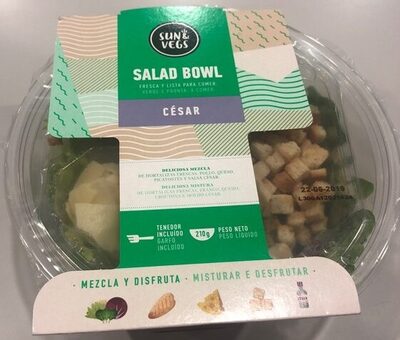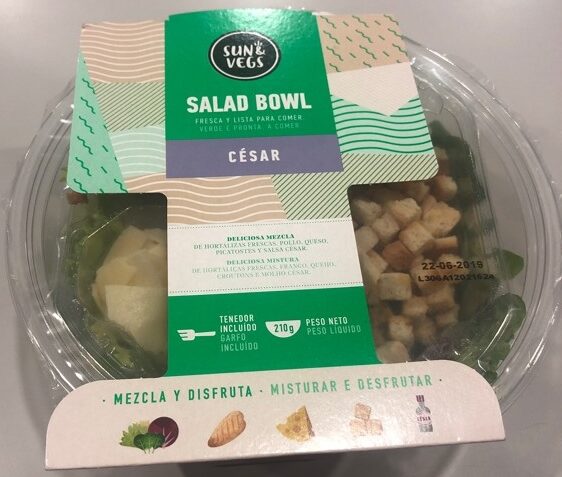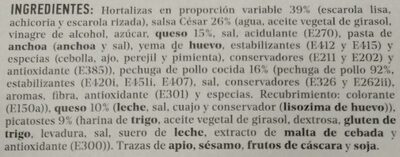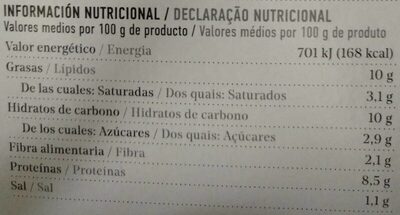Ajuda'ns a fer que la transparència alimentària sigui la norma!
Com a organització sense ànim de lucre, depenem de les vostres donacions per continuar informant els consumidors de tot el món sobre tot allò què mengen.
La revolució alimentària comença amb tu!
Salad Bowl César - Sun & Vegs - 210 g
Salad Bowl César - Sun & Vegs - 210 g
Aquesta pàgina del producte no està completa. Podeu ajudar a completar-la editant-la i afegint-hi més dades a partir de les fotos ja disponibles, o fent-ne més amb l'aplicació de androide o iPhone / iPad. Gràcies!
×
Codi de barres: 8437013139816 (EAN / EAN-13)
Quantitat: 210 g
Empaquetament: Plàstic
Marques: Sun & Vegs
Matching with your preferences
Salut
Ingredients
-
65 ingredients
: Hortalizas en proporción variable 39% (escarola lisa, achicoria y escarola rizada), salsa César 26% (agua, aceite vegetal de girasol, vinagre de alcohol, azúcar, queso 15%, sal, acidulante (E270), pasta de anchoa (anchoa y sal), yema de huevo, estabilizantes (E412 y E415) y especias (cebolla, ajo, perejil y pimienta), conservadores (E211 y E202) y antioxidante (E385)), pechuga de pollo cocida 16% (pechuga de pollo 92%, estabilizantes (E420i, E45li, E407), sal, conservadores (E326 y E262ii), aromas, fibra, antioxidante (E301) y especias. Recubrimiento: colorante (E150a)), queso 10% (leche, sal, cuajo y conservador (lisozima de huevo)), picatostes 9% (harina de trigo, aceite vegetal de girasol, dextrosa, gluten de trigo, levadura, sal, suero de leche, extracto de malta de cebada y antioxidante (E300)).Al·lèrgens: en:Gluten, en:Milk
Processament d'aliments
-
Aliments ultra processats
Elements que indiquen que el producte està al grup 4 - Aliments i begudes ultraprocessats:
- Additiu: E150a - Colorant de caramel
- Additiu: E326 - Lactat de potassi
- Additiu: E407 - Carragahen
- Additiu: E412 - Goma de guar
- Additiu: E415 - Goma de xantè
- Additiu: E420 - Sorbitol
- Ingredient: Color
- Ingredient: Dextrosa
- Ingredient: Aromes
- Ingredient: Glucosa
- Ingredient: Gluten
- Ingredient: Sèrum de llet
Els productes alimentaris es classifiquen en 4 grups segons el seu grau de processament:
- Aliments no processats o mínimament processats
- Ingredients culinaris processats
- Aliments processats
- Aliments ultra processats
La determinació del grup es fa en funció de la categoria del producte i dels ingredients que conté.
Additius
-
E202 - Sorbat de potassi
Potassium sorbate: Potassium sorbate is the potassium salt of sorbic acid, chemical formula CH3CH=CH−CH=CH−CO2K. It is a white salt that is very soluble in water -58.2% at 20 °C-. It is primarily used as a food preservative -E number 202-. Potassium sorbate is effective in a variety of applications including food, wine, and personal-care products. While sorbic acid is naturally occurring in some berries, virtually all of the world's production of sorbic acid, from which potassium sorbate is derived, is manufactured synthetically.Origen: Wikipedia (Anglès)
-
E211 - Benzoat de sodi
Sodium benzoate: Sodium benzoate is a substance which has the chemical formula NaC7H5O2. It is a widely used food preservative, with an E number of E211. It is the sodium salt of benzoic acid and exists in this form when dissolved in water. It can be produced by reacting sodium hydroxide with benzoic acid.Origen: Wikipedia (Anglès)
-
E262 - Acetats de sodi
Sodium acetate: Sodium acetate, CH3COONa, also abbreviated NaOAc, is the sodium salt of acetic acid. This colorless deliquescent salt has a wide range of uses.Origen: Wikipedia (Anglès)
-
E262ii
Sodium acetate: Sodium acetate, CH3COONa, also abbreviated NaOAc, is the sodium salt of acetic acid. This colorless deliquescent salt has a wide range of uses.Origen: Wikipedia (Anglès)
-
E270 - Àcid làctic
Lactic acid: Lactic acid is an organic compound with the formula CH3CH-OH-COOH. In its solid state, it is white and water-soluble. In its liquid state, it is colorless. It is produced both naturally and synthetically. With a hydroxyl group adjacent to the carboxyl group, lactic acid is classified as an alpha-hydroxy acid -AHA-. In the form of its conjugate base called lactate, it plays a role in several biochemical processes. In solution, it can ionize a proton from the carboxyl group, producing the lactate ion CH3CH-OH-CO−2. Compared to acetic acid, its pKa is 1 unit less, meaning lactic acid deprotonates ten times more easily than acetic acid does. This higher acidity is the consequence of the intramolecular hydrogen bonding between the α-hydroxyl and the carboxylate group. Lactic acid is chiral, consisting of two optical isomers. One is known as L--+--lactic acid or -S--lactic acid and the other, its mirror image, is D--−--lactic acid or -R--lactic acid. A mixture of the two in equal amounts is called DL-lactic acid, or racemic lactic acid. Lactic acid is hygroscopic. DL-lactic acid is miscible with water and with ethanol above its melting point which is around 17 or 18 °C. D-lactic acid and L-lactic acid have a higher melting point. In animals, L-lactate is constantly produced from pyruvate via the enzyme lactate dehydrogenase -LDH- in a process of fermentation during normal metabolism and exercise. It does not increase in concentration until the rate of lactate production exceeds the rate of lactate removal, which is governed by a number of factors, including monocarboxylate transporters, concentration and isoform of LDH, and oxidative capacity of tissues. The concentration of blood lactate is usually 1–2 mM at rest, but can rise to over 20 mM during intense exertion and as high as 25 mM afterward. In addition to other biological roles, L-lactic acid is the primary endogenous agonist of hydroxycarboxylic acid receptor 1 -HCA1-, which is a Gi/o-coupled G protein-coupled receptor -GPCR-.In industry, lactic acid fermentation is performed by lactic acid bacteria, which convert simple carbohydrates such as glucose, sucrose, or galactose to lactic acid. These bacteria can also grow in the mouth; the acid they produce is responsible for the tooth decay known as caries. In medicine, lactate is one of the main components of lactated Ringer's solution and Hartmann's solution. These intravenous fluids consist of sodium and potassium cations along with lactate and chloride anions in solution with distilled water, generally in concentrations isotonic with human blood. It is most commonly used for fluid resuscitation after blood loss due to trauma, surgery, or burns.Origen: Wikipedia (Anglès)
-
E301 - Ascorbat de sodi
Sodium ascorbate: Sodium ascorbate is one of a number of mineral salts of ascorbic acid -vitamin C-. The molecular formula of this chemical compound is C6H7NaO6. As the sodium salt of ascorbic acid, it is known as a mineral ascorbate. It has not been demonstrated to be more bioavailable than any other form of vitamin C supplement.Sodium ascorbate normally provides 131 mg of sodium per 1‚000 mg of ascorbic acid -1‚000 mg of sodium ascorbate contains 889 mg of ascorbic acid and 111 mg of sodium-. As a food additive, it has the E number E301 and is used as an antioxidant and an acidity regulator. It is approved for use as a food additive in the EU, USA, and Australia and New Zealand.In in vitro studies, sodium ascorbate has been found to produce cytotoxic effects in various malignant cell lines, which include melanoma cells that are particularly susceptible.Origen: Wikipedia (Anglès)
-
E326 - Lactat de potassi
Potassium lactate: Potassium lactate is a compound with formula KC3H5O3, or H3C-CHOH-COOK. It is the potassium salt of lactic acid. It is produced by neutralizing lactic acid which is fermented from a sugar source. It has E number "E326". Potassium lactate is a liquid product that is usually 60% solids but is available at up to 78% solids.Potassium lactate is commonly used in meat and poultry products to extend shelf life and increase food safety as it has a broad antimicrobial action and is effective at inhibiting most spoilage and pathogenic bacteria. Potassium lactate is also used as an extinguishing medium in the First Alert Tundra fire extinguishers.Origen: Wikipedia (Anglès)
-
E407 - Carragahen
Carrageenan: Carrageenans or carrageenins - karr-ə-gee-nənz, from Irish carraigín, "little rock"- are a family of linear sulfated polysaccharides that are extracted from red edible seaweeds. They are widely used in the food industry, for their gelling, thickening, and stabilizing properties. Their main application is in dairy and meat products, due to their strong binding to food proteins. There are three main varieties of carrageenan, which differ in their degree of sulfation. Kappa-carrageenan has one sulfate group per disaccharide, iota-carrageenan has two, and lambda-carrageenan has three. Gelatinous extracts of the Chondrus crispus -Irish moss- seaweed have been used as food additives since approximately the fifteenth century. Carrageenan is a vegetarian and vegan alternative to gelatin in some applications or may be used to replace gelatin in confectionery.Origen: Wikipedia (Anglès)
-
E412 - Goma de guar
Guar gum: Guar gum, also called guaran, is a galactomannan polysaccharide extracted from guar beans that has thickening and stabilizing properties useful in the food, feed and industrial applications. The guar seeds are mechanically dehusked, hydrated, milled and screened according to application. It is typically produced as a free-flowing, off-white powder.Origen: Wikipedia (Anglès)
-
E415 - Goma de xantè
Xanthan gum: Xanthan gum -- is a polysaccharide with many industrial uses, including as a common food additive. It is an effective thickening agent and stabilizer to prevent ingredients from separating. It can be produced from simple sugars using a fermentation process, and derives its name from the species of bacteria used, Xanthomonas campestris.Origen: Wikipedia (Anglès)
-
E420 - Sorbitol
Sorbitol: Sorbitol --, less commonly known as glucitol --, is a sugar alcohol with a sweet taste which the human body metabolizes slowly. It can be obtained by reduction of glucose, which changes the aldehyde group to a hydroxyl group. Most sorbitol is made from corn syrup, but it is also found in nature, for example in apples, pears, peaches, and prunes. It is converted to fructose by sorbitol-6-phosphate 2-dehydrogenase. Sorbitol is an isomer of mannitol, another sugar alcohol; the two differ only in the orientation of the hydroxyl group on carbon 2. While similar, the two sugar alcohols have very different sources in nature, melting points, and uses.Origen: Wikipedia (Anglès)
-
E420i
Sorbitol: Sorbitol --, less commonly known as glucitol --, is a sugar alcohol with a sweet taste which the human body metabolizes slowly. It can be obtained by reduction of glucose, which changes the aldehyde group to a hydroxyl group. Most sorbitol is made from corn syrup, but it is also found in nature, for example in apples, pears, peaches, and prunes. It is converted to fructose by sorbitol-6-phosphate 2-dehydrogenase. Sorbitol is an isomer of mannitol, another sugar alcohol; the two differ only in the orientation of the hydroxyl group on carbon 2. While similar, the two sugar alcohols have very different sources in nature, melting points, and uses.Origen: Wikipedia (Anglès)
Anàlisi dels ingredients
-
Es desconeix si conté oli de palma
Ingredients no reconeguts: es:salsa-cesar, es:e45li, es:recubrimiento, es:picatostesAlguns ingredients no s'han pogut reconèixer.
Necessitem la teva ajuda!
Podeu ajudar-nos a reconèixer més ingredients i analitzar millor la llista d'ingredients d'aquest producte i d'altres mitjançant:
- Editeu aquesta pàgina de producte per corregir les faltes d’ortografia de la llista d’ingredients i/o per eliminar els ingredients d’altres idiomes i frases que no estiguin relacionades amb els ingredients.
- Afegiu entrades, sinònims o traduccions noves a les nostres llistes multilingües d’ingredients, mètodes de processament d’ingredients i etiquetes.
Uniu-vos al canal #ingredients del nostre espai de discussió a Slack i/o apreneu sobre l'anàlisi dels ingredients en la nostra wiki, si voleu ajudar. Gràcies!
-
No és vegà
Ingredients no vegans: Formatge, Pasta d'anxova, Engràulid, Rovell d'ou, Pit de pollastre, Pit de pollastre, Formatge, Llet, Lisozim d'ou, Sèrum de lletAlguns ingredients no s'han pogut reconèixer.
Necessitem la teva ajuda!
Podeu ajudar-nos a reconèixer més ingredients i analitzar millor la llista d'ingredients d'aquest producte i d'altres mitjançant:
- Editeu aquesta pàgina de producte per corregir les faltes d’ortografia de la llista d’ingredients i/o per eliminar els ingredients d’altres idiomes i frases que no estiguin relacionades amb els ingredients.
- Afegiu entrades, sinònims o traduccions noves a les nostres llistes multilingües d’ingredients, mètodes de processament d’ingredients i etiquetes.
Uniu-vos al canal #ingredients del nostre espai de discussió a Slack i/o apreneu sobre l'anàlisi dels ingredients en la nostra wiki, si voleu ajudar. Gràcies!
-
No és vegetarià
Ingredients no vegetarians: Pasta d'anxova, Engràulid, Pit de pollastre, Pit de pollastre, Lisozim d'ouAlguns ingredients no s'han pogut reconèixer.
Necessitem la teva ajuda!
Podeu ajudar-nos a reconèixer més ingredients i analitzar millor la llista d'ingredients d'aquest producte i d'altres mitjançant:
- Editeu aquesta pàgina de producte per corregir les faltes d’ortografia de la llista d’ingredients i/o per eliminar els ingredients d’altres idiomes i frases que no estiguin relacionades amb els ingredients.
- Afegiu entrades, sinònims o traduccions noves a les nostres llistes multilingües d’ingredients, mètodes de processament d’ingredients i etiquetes.
Uniu-vos al canal #ingredients del nostre espai de discussió a Slack i/o apreneu sobre l'anàlisi dels ingredients en la nostra wiki, si voleu ajudar. Gràcies!
-
Detalls de l'anàlisi dels ingredients
Necessitem la teva ajuda!
Alguns ingredients no s'han pogut reconèixer.
Necessitem la teva ajuda!
Podeu ajudar-nos a reconèixer més ingredients i analitzar millor la llista d'ingredients d'aquest producte i d'altres mitjançant:
- Editeu aquesta pàgina de producte per corregir les faltes d’ortografia de la llista d’ingredients i/o per eliminar els ingredients d’altres idiomes i frases que no estiguin relacionades amb els ingredients.
- Afegiu entrades, sinònims o traduccions noves a les nostres llistes multilingües d’ingredients, mètodes de processament d’ingredients i etiquetes.
Uniu-vos al canal #ingredients del nostre espai de discussió a Slack i/o apreneu sobre l'anàlisi dels ingredients en la nostra wiki, si voleu ajudar. Gràcies!
: Hortalizas en proporción variable 39% (escarola lisa, achicoria, escarola rizada), salsa César 26% (agua, aceite vegetal de girasol, vinagre de alcohol, azúcar, queso 15%, sal, acidulante (e270), pasta de anchoa (anchoa, sal), yema de huevo, estabilizantes (e412, e415), especias (cebolla, ajo, perejil, pimienta), conservadores (e211, e202), antioxidante (e385)), pechuga de pollo 16% (pechuga de pollo 92%, estabilizantes (e420i, E45li, e407), sal, conservadores (e326, e262ii), aromas, fibra, antioxidante (e301), especias, Recubrimiento (colorante (e150a))), queso 10% (leche, sal, cuajo, conservador (lisozima de huevo)), picatostes 9% (harina de trigo, aceite vegetal de girasol, dextrosa, gluten de trigo, levadura, sal, suero de leche, extracto de malta de cebada, antioxidante (e300))- Hortalizas en proporción variable -> en:vegetables-in-variable-proportion - vegan: yes - vegetarian: yes - percent: 39
- escarola lisa -> en:broad-leaved-endive - vegan: yes - vegetarian: yes
- achicoria -> en:chicory - vegan: yes - vegetarian: yes - ciqual_food_code: 20026
- escarola rizada -> en:curly-endive - vegan: yes - vegetarian: yes - ciqual_food_code: 20012
- salsa César -> es:salsa-cesar - percent: 26
- agua -> en:water - vegan: yes - vegetarian: yes - ciqual_food_code: 18066
- aceite vegetal de girasol -> en:sunflower-oil - vegan: yes - vegetarian: yes - from_palm_oil: no - ciqual_food_code: 17440
- vinagre de alcohol -> en:alcohol-vinegar - vegan: yes - vegetarian: yes - ciqual_food_code: 11018
- azúcar -> en:sugar - vegan: yes - vegetarian: yes - ciqual_proxy_food_code: 31016
- queso -> en:cheese - vegan: no - vegetarian: maybe - ciqual_proxy_food_code: 12999 - percent: 15
- sal -> en:salt - vegan: yes - vegetarian: yes - ciqual_food_code: 11058
- acidulante -> en:acid
- e270 -> en:e270 - vegan: yes - vegetarian: yes
- pasta de anchoa -> en:anchovy-paste - vegan: no - vegetarian: no - ciqual_food_code: 26079
- anchoa -> en:anchovy - vegan: no - vegetarian: no - ciqual_food_code: 26079
- sal -> en:salt - vegan: yes - vegetarian: yes - ciqual_food_code: 11058
- yema de huevo -> en:egg-yolk - vegan: no - vegetarian: yes - ciqual_food_code: 22002
- estabilizantes -> en:stabiliser
- e412 -> en:e412 - vegan: yes - vegetarian: yes
- e415 -> en:e415 - vegan: yes - vegetarian: yes
- especias -> en:spice - vegan: yes - vegetarian: yes
- cebolla -> en:onion - vegan: yes - vegetarian: yes - ciqual_food_code: 20034
- ajo -> en:garlic - vegan: yes - vegetarian: yes - ciqual_food_code: 11000
- perejil -> en:parsley - vegan: yes - vegetarian: yes - ciqual_proxy_food_code: 11014
- pimienta -> en:pepper - vegan: yes - vegetarian: yes
- conservadores -> en:preservative
- e211 -> en:e211 - vegan: yes - vegetarian: yes
- e202 -> en:e202 - vegan: yes - vegetarian: yes
- antioxidante -> en:antioxidant
- e385 -> en:e385 - vegan: yes - vegetarian: yes
- pechuga de pollo -> en:chicken-breast - vegan: no - vegetarian: no - ciqual_food_code: 36018 - percent: 16
- pechuga de pollo -> en:chicken-breast - vegan: no - vegetarian: no - ciqual_food_code: 36018 - percent: 92
- estabilizantes -> en:stabiliser
- e420i -> en:e420i - vegan: yes - vegetarian: yes
- E45li -> es:e45li
- e407 -> en:e407 - vegan: yes - vegetarian: yes
- sal -> en:salt - vegan: yes - vegetarian: yes - ciqual_food_code: 11058
- conservadores -> en:preservative
- e326 -> en:e326 - vegan: yes - vegetarian: yes
- e262ii -> en:e262ii - vegan: yes - vegetarian: yes
- aromas -> en:flavouring - vegan: maybe - vegetarian: maybe
- fibra -> en:fiber
- antioxidante -> en:antioxidant
- e301 -> en:e301 - vegan: yes - vegetarian: yes
- especias -> en:spice - vegan: yes - vegetarian: yes
- Recubrimiento -> es:recubrimiento
- colorante -> en:colour
- e150a -> en:e150a - vegan: yes - vegetarian: yes
- colorante -> en:colour
- queso -> en:cheese - vegan: no - vegetarian: maybe - ciqual_proxy_food_code: 12999 - percent: 10
- leche -> en:milk - vegan: no - vegetarian: yes - ciqual_proxy_food_code: 19051
- sal -> en:salt - vegan: yes - vegetarian: yes - ciqual_food_code: 11058
- cuajo -> en:rennet - vegan: maybe - vegetarian: maybe
- conservador -> en:preservative
- lisozima de huevo -> en:lysozyme-from-eggs - vegan: no - vegetarian: no
- picatostes -> es:picatostes - percent: 9
- harina de trigo -> en:wheat-flour - vegan: yes - vegetarian: yes - ciqual_proxy_food_code: 9410
- aceite vegetal de girasol -> en:sunflower-oil - vegan: yes - vegetarian: yes - from_palm_oil: no - ciqual_food_code: 17440
- dextrosa -> en:dextrose - vegan: yes - vegetarian: yes - ciqual_proxy_food_code: 31016
- gluten de trigo -> en:wheat-gluten - vegan: yes - vegetarian: yes
- levadura -> en:yeast - vegan: yes - vegetarian: yes
- sal -> en:salt - vegan: yes - vegetarian: yes - ciqual_food_code: 11058
- suero de leche -> en:whey - vegan: no - vegetarian: maybe
- extracto de malta de cebada -> en:barley-malt-extract - vegan: yes - vegetarian: yes
- antioxidante -> en:antioxidant
- e300 -> en:e300 - vegan: yes - vegetarian: yes
Nutrició
-
Falten dades per calcular la Nutri-Score
Falta la categoria
⚠ ️S'ha d'especificar la categoria del producte per poder calcular el Nutri-Score.Podries afegir la informació necessària per calcular el Nutri-Score? Afegir una categoria
-
Informació nutricional
Informació nutricional Com es ven
per 100 g/100 mlCom es ven
per porció (210 g)Energia 701 kj
(168 kcal)1.470 kj
(353 kcal)Greix 10 g 21 g Àcid gras saturat 3,1 g 6,51 g Hidrats de carboni 10 g 21 g Sucre 2,9 g 6,09 g Fiber 2,1 g 4,41 g Proteïna 8,5 g 17,9 g Sal comuna 1,1 g 2,31 g Fruits‚ vegetables‚ nuts and rapeseed‚ walnut and olive oils (estimate from ingredients list analysis) 39 % 39 %
Entorn
-
Puntuació ecològica no calculada - Impacte ambiental desconegut
No hem pogut calcular l'Eco-Score d'aquest producte perquè li falten algunes dades, podríeu ajudar-nos a completar-lo?Podries afegir una categoria del producte més precisa perquè puguem calcular l'Eco-Score? Afegir una categoria
Empaquetament
-
Falta informació sobre l'embalatge d'aquest producte
⚠ ️ La informació sobre l'embalatge d'aquest producte no està completada.Take a photo of the recycling information Take a photo of the recycling information
Transport
-
Orígens dels ingredients
Falta informació sobre l'origen dels ingredients
⚠ ️ L'origen dels ingredients d'aquest producte no està indicat.
Si estan indicats a l'embalatge, podeu modificar la fitxa del producte i afegir-los.
Si sou el fabricant d'aquest producte, podeu enviar-nos la informació amb la nostra plataforma gratuïta per a productors.Add the origins of ingredients for this product Add the origins of ingredients for this product
Report a problem
-
Incomplete or incorrect information?
Category, labels, ingredients, allergens, nutritional information, photos etc.
If the information does not match the information on the packaging, please complete or correct it. Open Food Facts is a collaborative database, and every contribution is useful for all.
Fonts de dades
Producte afegit per elcoco
Última modificació de la pàgina del producte per thaialagata.
La pàgina del producte, també editada per elcoco.2867982acf94e3bc72f7ecab4c5fa5c3, feat, foodvisor, kiliweb, miguelndecarvalho, october-food-facts, roboto-app, yuka.ZVowa1ByVmZ1djRQbi9OdXhUejM2dlpKMnFHU1dWNmJLdTBBSVE9PQ.








